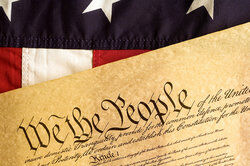
Because the U.S. government is a tripartite system, which means it has three branches, the country’s Constitution includes checks and balances that make all branches essentially equal. Some examples of checks and balances in the U.S. Constitution may be familiar, while others are relatively unknown.
U.S. Constitution Checks and Balances Examples
The U.S. Constitution is full of checks and balances of the three branches of government. The best example of checks and balances is that the president can veto any bill passed by Congress, but a two-thirds vote in Congress can override the veto.
Other examples include:
- The House of Representatives has sole power of impeachment, but the Senate has all power to try any impeachment.
- Any bills that intend to raise revenue must originate in the House of Representatives, but the Senate also has to approve the bill.
- Congress has the power to set and collect any taxes or duties.
- The president is commander-in-chief of the U.S. Army and Navy.
- The president has the power to grant pardons and reprieves for crimes against the U.S. except in an impeachment.
- The president can make treaties, but only with a two-thirds agreement from the Senate.
- The House of Representatives and the Senate both have to pass the same bill before it can become a law.
- The president can appoint Supreme Court judges, but the Senate must approve these choices.
- Supreme Court judges have the power to declare presidential actions as unconstitutional.
- The vice president is also automatically the president of the Senate.
- Congress can amend the Constitution, which means they can override a Supreme Court decision.
Checks and Balances Definition
The definition of checks and balances is simply a system for distributing governmental powers. Each branch of the government has specific procedures only they can follow that help protect against fraud, errors, and illegal actions. These special procedures are distributed as evenly as possible so no one segment has ultimate power or more power than any other.
A system of checks and balances can be found in almost any constitutional government, not just in the United States.
Methodology
In 1787, several U.S. states got together to update the Articles of Confederation, which was the current way states work together as one group. The goal was to create a U.S. Constitution that would give a central government power to act nationally, but not take away the rights of any state or its people.
They specifically wanted to avoid a government that copied the king of England and his parliament.
Separation of Powers
The power of the new government was split into three branches, creating a clear separation of powers. The three branches of government are:
- The executive branch (President, Vice President and cabinet) carries out laws.
- The legislative branch (Congress: Senate and House of Representatives) makes laws.
- The judicial branch (Supreme Court and other federal courts) interprets laws.
Once these branches were established, Congress realized they’d need to make sure no branch could simply overtake the others. This is where the system of checks and balances came in.
Articles of the Constitution
The specific powers of each branch of the government were outlined in the Constitution. Any powers not specifically noted were meant to be under the control of individual states. You can find out how the government structure was set up and what each branch is responsible for by looking at the Articles of the Constitution.
The first three Articles tell you more details about each branch of the government:
- Article I outlines the powers of Congress, or the legislative branch.
- Article II outlines the executive branch and the powers of the president and vice president.
- Article III outlines the judicial powers of the judicial branch.
Modern Examples of Checks and Balances
A quick scan of major new stories over the last couple decades will show you examples of checks and balances in modern times.
- In 1996, the Defense of Marriage Act (DOMA) was signed into law by President Bill Clinton. It declared that the federal definition of marriage was between a man and a woman. In 2015, the Supreme Court ruled that same-sex marriage was legal in federal terms.
- In 1998, the House of Representatives brought impeachment charges against President Bill Clinton, but the Senate acquitted him.
- In 2016, Congress overrode a veto by President Barack Obama over the issue of families of 9/11 victims being allowed to sue Saudi Arabia.
The Constitution in Action
Take a look at current events and you’ll probably see examples of checks and balances today in government proceedings. The president of the United States changes every four years, or eight years if a president is re-elected, and some government positions change more frequently. This keeps the system of checks and balances relevant as beliefs, attitudes, and opinions change. Continue exploring governmental powers by learning about the 25th Amendment.